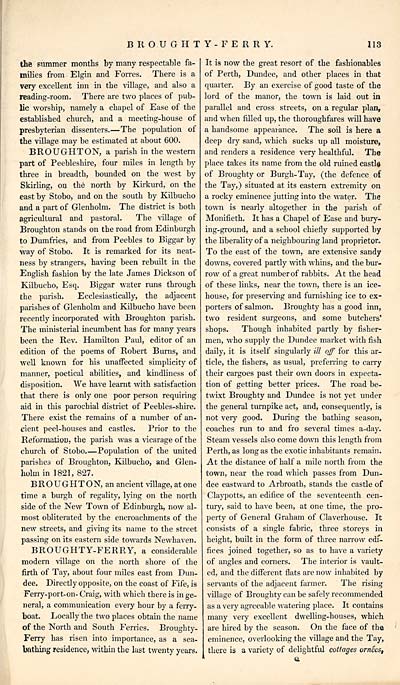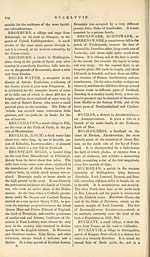Gazetteer of Scotland > Volume 1
(141) Page 113
Download files
Complete book:
Individual page:
Thumbnail gallery: Grid view | List view

B It OUGHTY- FERRY.
113
the summer months by many respectable fa-
milies from Elgin and Forres. There is a
very excellent inn in the village, and also a
reading-room. There are two places of pub-
lic worship, namely a chapel of Ease of the
established church, and a meeting-house of
presbyterian dissenters. — The population of
the village may be estimated at about 600.
BROUGHTON, a parish in the western
part of Peebleshire, four miles in length by
three in breadth, bounded on the west by
Skirling, on the north by Kirkurd, on the
east by Stobo, and on the south by Kilbucho
and a part of Glenholm. The district is both
agricultural and pastoral. The village of
Broughton stands on the road from Edinburgh
to Dumfries, and from Peebles to Biggar by
way of Stobo. It is remarked for its neat-
ness by strangers, having been rebuilt in the
English fashion by the late James Dickson of
Kilbucho, Esq. Biggar water runs through
the parish. Ecclesiastically, the adjacent
parishes of Glenholm and Kilbucho have been
recently incorporated with Broughton parish.
The ministerial incumbent has for many years
been the Rev. Hamilton Paul, editor of an
edition of the poems of Robert Burns, and
well known for his unaffected simplicity of
manner, poetical abilities, and kindliness of
disposition. We have learnt with satisfaction
that there is only one poor person requiring
aid in this parochial district of Peebles-shire.
There exist the remains of a number of an-
cient peel-houses and castles. Prior to the
Reformation, the parish was a vicarage of the
church of Stobo. — Population of the united
parishes of Broughton, Kilbucho, and Glen-
holm in 1821, 827.
B R O U G H T O N, an ancient village, at one
time a burgh of regality, lying on the north
side of the New Town of Edinburgh, now al-
most obliterated by the encroachments of the
new streets, and giving its name to the street
passing on its eastern side towards Newhaven.
BROUGHTY-FERRY, a considerable
modern village on the north shore of the
firth of Tay, about four miles east from Dun-
dee. Directly opposite, on the coast of Fife, is
Ferry-port-on- Craig, with which there is in ge-
neral, a communication every hour by a ferry-
boat. Locally the two places obtain the name
of the North and South Ferries. Broughty-
Ferry has risen into importance, as a sea-
bathing residence, within the last twenty years.
It is now the great resort of the fashionables
of Perth, Dundee, and other places in that
quarter. By an exercise of good taste of the
lord of the manor, the town is laid out in
parallel and cross streets, on a regular plan,
and when filled up, the thoroughfares will have
a handsome appearance. The soil is here a
deep dry sand, which sucks up all moisture,
and renders a residence very healthful. The
place takes its name from the old ruined casthj
of Broughty or Burgh- Tay, (the defence of
the Tay,) situated at its eastern extremity on
a rocky eminence jutting into the water. The
town is nearly altogether in the parish of
Monifieth. It has a Chapel of Ease and bury-
ing-ground, and a school chiefly supported by
the liberality of a neighbouring land proprietor.
To the east of the town, are extensive sandy
downs, covered partly with whins, and the bur-
row of a great number of rabbits. At the head
of these links, near the town, there is an ice-
house, for preserving and furnishing ice to ex-
porters of salmon. Broughty has a good inn,
two resident surgeons, and some butchers'
shops. Though inhabited partly by fisher-
men, who supply the Dundee market with fish
daily, it is itself singularly ill off for this ar-
ticle, the fishers, as usual, preferring to carry
their cargoes past their own doors in expecta-
tion of getting better prices. The road be-
twixt Broughty and Dundee is not yet under
the general turnpike act, and, consequently, is
not very good. During the bathing season,
coaches run to and fro several times a-day.
Steam vessels also come down this length from
Perth, as long as the exotic inhabitants remain.
At the distance of half a mile north from the
town, near the road which passes from Dun-
dee eastward to Arbroath, stands the castle of
Claypotts, an edifice of the seventeenth cen-
tury, said to have been, at one time, the pro-
perty of General Graham of Claverhouse. It
consists of a single fabric, three storeys in
height, built in the form of three narrow edi-
fices joined together, so as to have a variety
of angles and comers. The interior is vault-
ed, and the different flats are now inhabited by
servants of the adjacent farmer. The rising
village of Broughty can be safely recommended
as a veiy agreeable watering place. It contains
many veiy excellent dwelling-houses, which
are hired by the season. On the face of the
eminence, overlooking the village and the Tay,
there is a variety of delightful cottages ornees,
a
113
the summer months by many respectable fa-
milies from Elgin and Forres. There is a
very excellent inn in the village, and also a
reading-room. There are two places of pub-
lic worship, namely a chapel of Ease of the
established church, and a meeting-house of
presbyterian dissenters. — The population of
the village may be estimated at about 600.
BROUGHTON, a parish in the western
part of Peebleshire, four miles in length by
three in breadth, bounded on the west by
Skirling, on the north by Kirkurd, on the
east by Stobo, and on the south by Kilbucho
and a part of Glenholm. The district is both
agricultural and pastoral. The village of
Broughton stands on the road from Edinburgh
to Dumfries, and from Peebles to Biggar by
way of Stobo. It is remarked for its neat-
ness by strangers, having been rebuilt in the
English fashion by the late James Dickson of
Kilbucho, Esq. Biggar water runs through
the parish. Ecclesiastically, the adjacent
parishes of Glenholm and Kilbucho have been
recently incorporated with Broughton parish.
The ministerial incumbent has for many years
been the Rev. Hamilton Paul, editor of an
edition of the poems of Robert Burns, and
well known for his unaffected simplicity of
manner, poetical abilities, and kindliness of
disposition. We have learnt with satisfaction
that there is only one poor person requiring
aid in this parochial district of Peebles-shire.
There exist the remains of a number of an-
cient peel-houses and castles. Prior to the
Reformation, the parish was a vicarage of the
church of Stobo. — Population of the united
parishes of Broughton, Kilbucho, and Glen-
holm in 1821, 827.
B R O U G H T O N, an ancient village, at one
time a burgh of regality, lying on the north
side of the New Town of Edinburgh, now al-
most obliterated by the encroachments of the
new streets, and giving its name to the street
passing on its eastern side towards Newhaven.
BROUGHTY-FERRY, a considerable
modern village on the north shore of the
firth of Tay, about four miles east from Dun-
dee. Directly opposite, on the coast of Fife, is
Ferry-port-on- Craig, with which there is in ge-
neral, a communication every hour by a ferry-
boat. Locally the two places obtain the name
of the North and South Ferries. Broughty-
Ferry has risen into importance, as a sea-
bathing residence, within the last twenty years.
It is now the great resort of the fashionables
of Perth, Dundee, and other places in that
quarter. By an exercise of good taste of the
lord of the manor, the town is laid out in
parallel and cross streets, on a regular plan,
and when filled up, the thoroughfares will have
a handsome appearance. The soil is here a
deep dry sand, which sucks up all moisture,
and renders a residence very healthful. The
place takes its name from the old ruined casthj
of Broughty or Burgh- Tay, (the defence of
the Tay,) situated at its eastern extremity on
a rocky eminence jutting into the water. The
town is nearly altogether in the parish of
Monifieth. It has a Chapel of Ease and bury-
ing-ground, and a school chiefly supported by
the liberality of a neighbouring land proprietor.
To the east of the town, are extensive sandy
downs, covered partly with whins, and the bur-
row of a great number of rabbits. At the head
of these links, near the town, there is an ice-
house, for preserving and furnishing ice to ex-
porters of salmon. Broughty has a good inn,
two resident surgeons, and some butchers'
shops. Though inhabited partly by fisher-
men, who supply the Dundee market with fish
daily, it is itself singularly ill off for this ar-
ticle, the fishers, as usual, preferring to carry
their cargoes past their own doors in expecta-
tion of getting better prices. The road be-
twixt Broughty and Dundee is not yet under
the general turnpike act, and, consequently, is
not very good. During the bathing season,
coaches run to and fro several times a-day.
Steam vessels also come down this length from
Perth, as long as the exotic inhabitants remain.
At the distance of half a mile north from the
town, near the road which passes from Dun-
dee eastward to Arbroath, stands the castle of
Claypotts, an edifice of the seventeenth cen-
tury, said to have been, at one time, the pro-
perty of General Graham of Claverhouse. It
consists of a single fabric, three storeys in
height, built in the form of three narrow edi-
fices joined together, so as to have a variety
of angles and comers. The interior is vault-
ed, and the different flats are now inhabited by
servants of the adjacent farmer. The rising
village of Broughty can be safely recommended
as a veiy agreeable watering place. It contains
many veiy excellent dwelling-houses, which
are hired by the season. On the face of the
eminence, overlooking the village and the Tay,
there is a variety of delightful cottages ornees,
a
Set display mode to: Large image | Transcription
Images and transcriptions on this page, including medium image downloads, may be used under the Creative Commons Attribution 4.0 International Licence unless otherwise stated. ![]()
| Gazetteers of Scotland, 1803-1901 > Gazetteer of Scotland > Volume 1 > (141) Page 113 |
|---|
| Permanent URL | https://digital.nls.uk/97426054 |
|---|
| Description | Volume I: Abbey to Glenartney. |
|---|---|
| Attribution and copyright: |
|
| Description | By Robert Chambers and William Chambers. Glasgow: Blackie & Son, 1838. 2 volumes. |
|---|---|
| Shelfmark | NF.1461.g.7 |
| Additional NLS resources: | |

